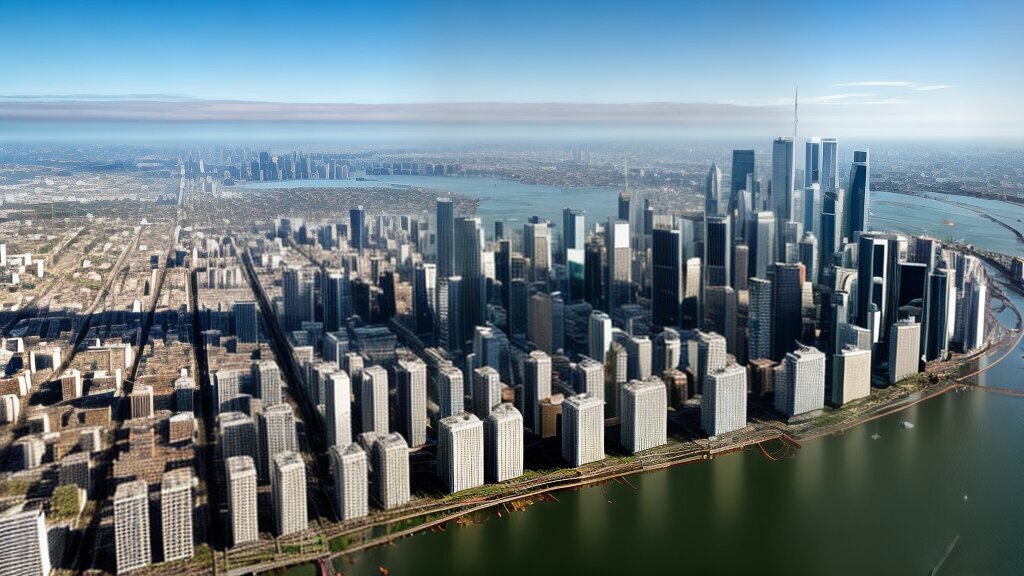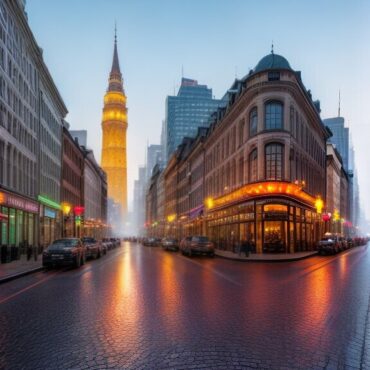Welcome to our article on the importance of urban planning for building resilient cities. As we face unprecedented challenges in the 21st century, from the impacts of climate change to the increasing frequency and severity of disasters, it is essential that our cities are equipped to withstand shocks and stresses. Urban planning plays a critical role in building resilience, from developing infrastructure that can withstand disasters, to creating frameworks for climate change adaptation and community resilience.
Through this article, we will explore the importance of urban planning for resilience and highlight various strategies for building more resilient cities. From the integration of resilience into infrastructure development, to the engagement of communities in the planning process, we will examine real-world examples of cities that have successfully implemented urban planning for resilience, providing inspiration and practical insights for other cities.
Key Takeaways:
- Urban planning is critical to building resilient cities that can withstand shocks and stresses.
- Resilient cities require infrastructure that can withstand disasters, frameworks for climate change adaptation and community resilience.
- Through various strategies such as integrating resilience into infrastructure development and engaging communities in the planning process, cities can become more resilient.
- Real-world examples of successful urban planning for resilience provide inspiration and practical insights for other cities.
The Importance of Sustainable Urban Planning
In order to build resilient cities that can withstand the challenges of the 21st century, sustainable urban planning is essential. Environmental, social and economic sustainability must be incorporated into planning processes to ensure that cities are well-equipped to face shocks and stresses.
At the heart of sustainable urban planning is the need for resilient infrastructure. Infrastructure must be designed to withstand both acute shocks, such as natural disasters, and chronic stresses such as traffic congestion, air pollution and water scarcity. By investing in resilient infrastructure, cities can better manage the impacts of shocks and stresses, while also reducing long-term risks.
There are various urban resilience strategies that can be used in sustainable urban planning, including green infrastructure, integrated water management and smart technology. Green infrastructure, such as parks, green roofs, and vegetated swales, can improve air and water quality, reduce urban heat island effects, and mitigate flooding. Integrated water management, such as rainwater harvesting and graywater reuse, can help to reduce water demand and improve water quality. Smart technology, such as sensors and real-time data analysis, can help to improve city services and increase efficiency.
Sustainable urban planning must also prioritize community engagement and participation. By involving local communities in planning processes, cities can ensure that resilience strategies are tailored to local needs and reflect the values and aspirations of the community.

“Sustainable urban planning is critical for building cities that can withstand the challenges of the 21st century. Resilient infrastructure, urban resilience strategies and community involvement are essential components of sustainable urban planning.”
Climate Change Adaptation in Urban Planning
As climate change continues to impact cities around the world, urban planning must adapt to ensure resilience and sustainability. The Global Covenant of Mayors estimates that over 70% of cities are already experiencing the effects of climate change, including rising sea levels, increased frequency and intensity of extreme weather events, and changes in temperature and precipitation patterns.
Adapting to these changes requires a comprehensive urban resilience framework that addresses both acute shocks and chronic stresses. This includes incorporating climate change adaptation strategies into urban planning processes.
One approach is to prioritize infrastructure that can withstand the impacts of climate change, such as flooding, extreme heat or cold, and high winds. This includes green infrastructure solutions, such as incorporating green roofs, parks, and open spaces to reduce heat island effects and increase stormwater absorption.
Another approach is to adopt building codes and standards that consider the long-term impacts of climate change, such as designing structures to withstand increased flood levels and high winds. Additionally, zoning can ensure that new developments are located in areas that are less vulnerable to climate-related risks.
Overall, urban planning plays a critical role in climate change adaptation by creating resilient and sustainable cities that can withstand the challenges of the 21st century.

Sustainable infrastructure is key for climate change adaptation in urban planning.
Disaster Risk Reduction in Urban Planning
Disasters can strike anywhere at any time, causing significant damage to cities and populations. Urban planning can play a crucial role in reducing disaster risk and enhancing community resilience. Disaster risk reduction strategies can be incorporated into urban planning processes, helping to create cities that are better prepared for disaster events.
One effective strategy for disaster risk reduction is the use of green infrastructure. Green infrastructure includes natural features such as parks, green roofs, and wetlands, which can help to reduce the impact of disasters by absorbing and filtering water, reducing stormwater runoff, and providing habitat for wildlife. For example, Philadelphia’s Green City, Clean Waters program uses green infrastructure to reduce stormwater runoff and improve water quality.
| Benefits of Green Infrastructure |
Examples of Green Infrastructure |
| Reduces stormwater runoff |
Green roofs |
| Improves air and water quality |
Parks and open spaces |
| Reduces urban heat island effect |
Green alleys and streets |
Community involvement is also essential in disaster risk reduction. Engaging communities in the planning and implementation of disaster risk reduction strategies can help to ensure that their unique needs and perspectives are taken into account. Community-led initiatives such as the Rooftop Garden Project in New York City promote community involvement in green infrastructure projects and help to strengthen community resilience.

By incorporating disaster risk reduction strategies into urban planning processes, cities can become more resilient to disasters and better equipped to respond to and recover from them. These strategies can help to reduce vulnerabilities, protect communities, and enhance overall quality of life.
Urban Resilience Indicators: Measuring Progress
Measuring progress in urban resilience is essential to assess the effectiveness of planning efforts and monitor the resilience of cities over time. Urban resilience indicators provide a framework for this assessment, offering a way to quantify and track progress towards more resilient cities.
Urban resilience indicators are quantitative or qualitative criteria used to measure the resilience of cities. They allow for the collection and analysis of data on a range of factors, such as infrastructure, social cohesion, and community engagement. By tracking these indicators over time, cities can identify areas for improvement and measure the impact of resilience-building efforts.
There are many different types of urban resilience indicators, each focusing on different aspects of resilience. For example, some indicators focus on the physical infrastructure of cities, such as the quality and reliability of water and energy systems. Others focus on social capital, such as the level of social cohesion and engagement in a community.
| Examples of Urban Resilience Indicators |
What They Measure |
| Number of green spaces per capita |
Availability of natural areas that support biodiversity and provide recreational opportunities, contributing to the overall resilience of the city |
| Proportion of public transport users |
Access to reliable, affordable, and low-carbon transportation options that are less vulnerable to disruption during disasters or other emergencies |
| Community disaster preparedness |
Level of readiness and resilience in a community, including awareness of potential hazards, emergency planning and response, and community networks and support systems |
Using urban resilience indicators can help cities identify areas where they need to improve their resilience, as well as track progress over time. This can help inform decision-making around urban planning and resilience-building strategies. For example, if a city has a low score on an indicator related to social cohesion, it may indicate a need to develop community engagement strategies and strengthen social networks.

Overall, the use of urban resilience indicators is essential for building more resilient cities. By measuring progress and identifying areas for improvement, cities can develop more effective strategies and investments to create a more resilient future.
Engaging Communities in Resilient Planning
Community involvement is key to building resilient cities. Engaging residents in the planning process ensures that their needs and concerns are understood and addressed. It also fosters a sense of ownership and responsibility for the city’s resilience, empowering individuals to take action to protect themselves and their communities.
One effective strategy for engaging communities is through participatory planning processes. This involves bringing together stakeholders from diverse backgrounds to collaboratively design solutions that address the specific challenges faced by their community. By working together, community members can identify and prioritize key issues, and develop practical strategies for building resilience.
Examples of Participatory Planning Processes
Vancouver, Canada: When developing its Greenest City Action Plan, the City of Vancouver engaged residents through a variety of mechanisms, including online surveys, community workshops, and social media outreach. This allowed residents to provide input into the plan and ensured that it reflected the needs and priorities of the community.
Medellin, Colombia: The city of Medellin has implemented a range of participatory planning processes, including community budgeting, where residents can propose and vote on projects for their neighbourhoods, and community councils, which are responsible for identifying and addressing local issues. These initiatives have helped to build trust between residents and local government, and improve the resilience of communities to a variety of shocks and stresses.
Best Practices for Engaging Communities
Engaging communities in resilient planning requires careful consideration of a range of factors. Key principles include:
- Building trust with community members through transparent and inclusive processes
- Recognising and valuing the perspectives and knowledge of community members, particularly those who are often marginalised or underrepresented
- Providing opportunities for meaningful participation, such as through co-design or participatory budgeting processes
- Ensuring that language, cultural, and other barriers to participation are identified and addressed
By following these best practices, cities can effectively engage communities in building resilience, leading to more effective and equitable outcomes for all residents.

Integrating Resilience into Infrastructure Development
Infrastructure is a critical component of urban resilience, providing the essential services and systems that keep our cities functioning. However, traditional infrastructure is often designed and built without taking into account the risks and challenges of the 21st century.
Resilient infrastructure, on the other hand, is designed to withstand both acute shocks and chronic stresses, ensuring that it can continue to function in the face of a wide range of challenges. This includes integrating features such as green spaces, flood barriers, and greywater systems into infrastructure design.
One example of this is seen in Rotterdam, where the city has implemented a multifunctional water storage system that not only prevents flooding, but also provides recreational space for the community.
Integrating resilience into infrastructure development is an essential part of building resilient cities. By considering the risks and challenges of the 21st century in infrastructure design, we can ensure that our cities remain functional and continue to support our communities in the face of adversity.

Building Resilient Infrastructure
When designing resilient infrastructure, it is important to consider a range of strategies that can help to enhance resilience. These might include:
- Integrating green spaces into urban design to reduce the urban heat island effect and provide a natural source of cooling
- Implementing greywater systems to reduce water consumption and address water scarcity
- Creating flood barriers and other water management systems to prevent flooding and reduce water damage
- Building redundant systems for critical infrastructure to ensure that service continuity can be maintained in the event of a failure
These strategies can help to improve the resilience of infrastructure and ensure that it can continue to function in the face of a wide range of challenges.
“By considering the risks and challenges of the 21st century in infrastructure design, we can ensure that our cities remain functional and continue to support our communities in the face of adversity.”
Case Studies: Resilient Cities in Action
Real-world examples of cities that have successfully implemented urban planning for resilience provide inspiration and practical insights for other cities. Let’s take a look at some case studies:
Rio de Janeiro, Brazil: Building Resilience Through Citizen Engagement
“By fostering citizen engagement and participation in urban planning, we are building resilient communities that can withstand the shocks and stresses of the 21st century.” – Mayor Eduardo Paes, Rio de Janeiro
Rio de Janeiro has undertaken significant efforts to build resilience through citizen engagement. The city has established a participatory budgeting process, where residents can vote on how public funds are spent, helping to ensure that infrastructure investments are aligned with community needs. In addition, Rio de Janeiro has implemented a variety of programs aimed at improving disaster risk management and climate change adaptation, such as the Resilient Rio initiative, which aims to create a more resilient city by addressing social, economic, and environmental challenges through sustainable and inclusive development.

Christchurch, New Zealand: Rebuilding After Disaster
“We have an opportunity to rebuild a better, more resilient city that can withstand future shocks and stresses.” – Bob Parker, Former Mayor of Christchurch
After experiencing a devastating earthquake in 2011, Christchurch embarked on an ambitious effort to rebuild as a more resilient city. The rebuilding effort incorporated a variety of innovative strategies, such as raised building foundations, underground water storage, and green infrastructure, which help to mitigate the impact of future disasters. In addition, Christchurch has invested in community engagement and participation, such as opening a community-led regeneration project that encourages residents to take an active role in rebuilding their neighbourhoods.

Hamburg, Germany: Addressing Climate Change Through Innovative Infrastructure
“We recognise that addressing climate change requires innovative solutions and investments in sustainable infrastructure that can help us build a more resilient city for the future.” – Mayor Olaf Scholz, Hamburg
Hamburg has taken an innovative approach to addressing climate change through its infrastructural investments. The city has invested in green roofs, which help to reduce the heat island effect and enhance building insulation. Additionally, Hamburg has implemented a program to provide incentives for property owners to retrofit their buildings to be more energy-efficient. These efforts have helped to make Hamburg a more resilient and sustainable city overall.

Conclusion
Urban planning is crucial in building resilience in cities, particularly in the face of the challenges that come with the 21st century. From climate change adaptation to disaster risk reduction, resilient urban planning strategies are essential in creating cities that can withstand shocks and stresses.
As we have seen, sustainable urban planning is key to building resilient infrastructure that can enhance community resilience. Urban planning must be adapted to develop resilience frameworks that address the impacts of climate change and incorporate risk reduction measures.
Measuring progress in urban resilience is also important in assessing the effectiveness of planning efforts and monitoring the resilience of cities over time. Communities must be engaged in the planning process to create resilient cities that work for everyone.
Integrating resilience into infrastructure development is crucial in creating infrastructure that is capable of withstanding acute shocks and chronic stresses. Case studies of cities that have successfully implemented urban planning for resilience provide inspiration and practical insights for other cities.
In conclusion, urban planning for resilience is a must for cities looking to adapt to the challenges of the 21st century. It is important that cities incorporate these strategies in their planning processes to ensure that their communities are prepared for any eventuality.
FAQ
Q: What is urban planning for resilience?
A: Urban planning for resilience refers to the process of designing and managing cities in a way that allows them to effectively adapt and respond to the challenges of the 21st century. It involves developing strategies and approaches that enhance a city’s ability to withstand shocks and stresses, such as climate change and disasters.
Q: Why is sustainable urban planning important?
A: Sustainable urban planning is crucial in building resilient cities. It focuses on creating infrastructure and systems that are environmentally-friendly, socially inclusive, and economically viable. By incorporating sustainable practices into planning processes, cities can enhance their resilience and ensure long-term sustainability.
Q: How does urban planning contribute to climate change adaptation?
A: Urban planning plays a key role in adapting to climate change. It involves developing resilience frameworks that address the impacts of climate change and integrating adaptation measures into city design and infrastructure. By incorporating climate considerations into planning processes, cities can become more resilient to the challenges posed by changing climatic conditions.
Q: What is the importance of disaster risk reduction in urban planning?
A: Disaster risk reduction strategies are essential in urban planning to enhance community resilience. By integrating risk reduction measures into planning processes, cities can mitigate the potential impacts of disasters and build more resilient communities. This includes measures such as improved infrastructure, early warning systems, and community preparedness.
Q: How are urban resilience indicators used in measuring progress?
A: Urban resilience indicators are used to assess the effectiveness of planning efforts and monitor the resilience of cities over time. These indicators provide a quantitative and qualitative way to measure progress and identify areas for improvement. By tracking and analyzing these indicators, cities can make informed decisions to enhance their resilience.
Q: Why is community engagement important in resilient planning?
A: Community engagement is vital in resilient planning as it ensures that the needs and concerns of the community are taken into account. By involving communities in the planning process, cities can create more inclusive and effective strategies for building resilience. Community engagement also fosters a sense of ownership and empowers residents to actively contribute to the development of their cities.
Q: How can resilience be integrated into infrastructure development?
A: Resilience can be integrated into infrastructure development by designing and constructing infrastructure that can withstand both acute shocks and chronic stresses. This involves considering climate change impacts, incorporating redundancy and flexibility into infrastructure systems, and utilizing innovative design and construction techniques. By incorporating resilience into infrastructure development, cities can ensure the long-term functionality and adaptability of their infrastructure.
Q: Can you provide examples of resilient cities in action?
A: Certainly! There are many cities around the world that have successfully implemented urban planning for resilience. For example, Copenhagen in Denmark is renowned for its climate change adaptation strategies, including the development of sustainable transportation and flood management systems. New York City is another great example, with its comprehensive disaster risk reduction and recovery planning following Hurricane Sandy. These case studies demonstrate the effectiveness of urban planning in building resilient cities and serve as inspiration for other cities facing similar challenges.



























Post comments (0)